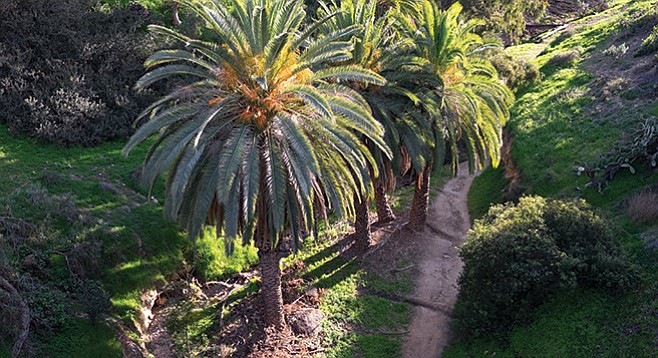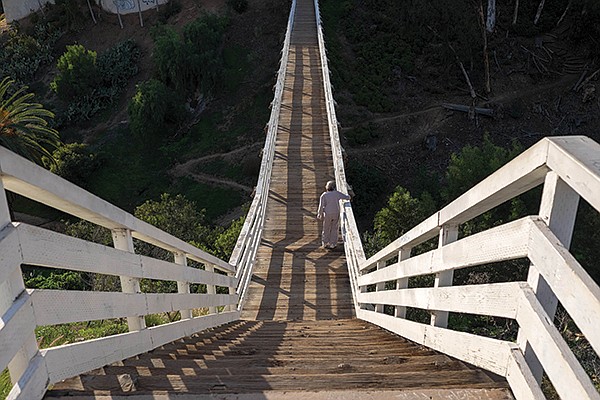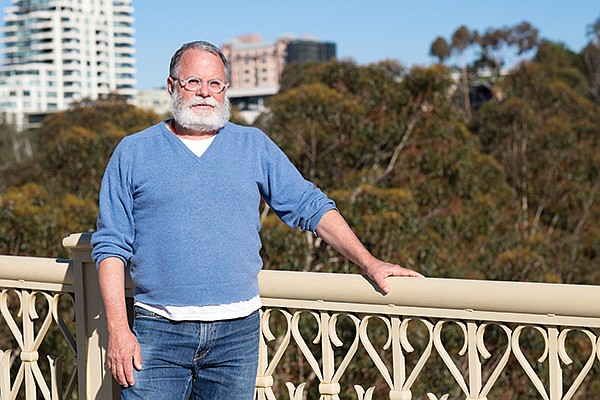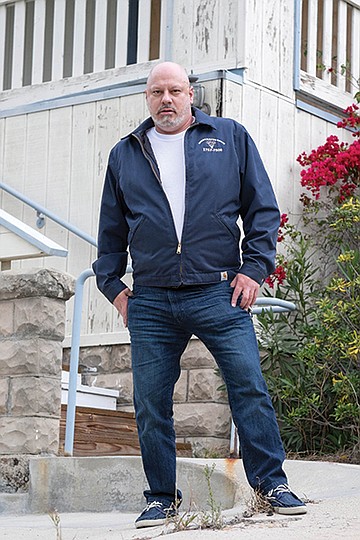 Facebook
Facebook
 X
X
 Instagram
Instagram
 TikTok
TikTok
 Youtube
Youtube

From above, Maple Canyon appears as a finger reaching for air from Uptown San Diego’s dense urban landscape.
The canyon curves southwest from Bankers Hill to the edge of Little Italy. Residents and tourists descend into the canyon to access a popular hiking trail. Dozens of eucalyptus trees, planted by Kate Sessions in 1911, tower over the canyon. The trail runs underneath two historic bridges on Quince Street and First Avenue.

At its western terminus, at Laurel and Union streets, sits a small .68 acre parcel of land with two wooden houses, one of which is boarded up and vacant. The parcel is owned by the City of San Diego.
This month, city councilmembers will be asked to approve a proposal from the Real Estate Assets Department to sell the plot of land at market value. Staffers from San Diego’s Planning Department have told residents that the parcel has too steep of a grade and is too small for a park. There is also no direct link, or walking trail, into Maple Canyon.
Because of those issues, the department recommends that the council sell the property. The vote will occur without any input from the community planning group and without substantial public comment.
The clock is now ticking for Uptown residents to voice their objections to the sale and give reasons why the city should turn the area into a small neighborhood park where visitors can access a trail into the undeveloped canyon.
Adding to the residents’ frustration is the fact that the parcel was identified as “public open space” on Uptown’s Draft Community Plan Update. If the parcel remains designated as such in the community plan update, the land would be made into a public park and residents could work toward forging a footpath from the plot of land into the canyon.
But Katie Keach, deputy chief of staff for councilmember Todd Gloria, says the planning department erred by placing the property on the list of potential open space. “The property is shown as public open space on the parks map, however, it is not mentioned anywhere in the plan other than on the map,” writes Keach in a December 4 email. “Our office has been told that this was a mapping error which has since been corrected and removed. It will not be indicated as open space on the map for the next draft of the plan that goes out for public review.
Keach says the parcel will be designated “residential-medium high,” which allows for the land to be used to build 29 housing units.
The impending decision to sell the property in addition to years of frustration caused by city officials’ previous refusal to set aside park space in Uptown has angered residents. In response, at a November 2015 meeting of the area’s planning group, Uptown Planners, the group placed a moratorium on the sale of any city-owned property. “We are up for a fight to get this parcel as part of Maple Canyon, because if we don’t we will have given up an opportunity that will matter for generations,” says Roy McMakin, president of the group Friends of Maple Canyon.

“Our neighborhood is very engaged and is always thinking long-term,” adds McMakin. “Given many folks are retired, they are often thinking beyond the time they will live here. There is a commitment to restoring the native habitat to the canyon as well as making it a safer place for residents of all ages and abilities to enjoy.”
But the city has a poor track record when it comes to setting aside public land for parks and open space. As reported by the Reader, the city became embroiled in a long legal battle in 1981, when descendants of a family who granted a parcel of land on Olive Street in Bankers Hill to the city for use as a public park sued the city after officials allowed a neighboring land owner to use the park as a parking lot for his medical building. Litigation is still ongoing in that case, despite the fact that the city eventually turned the small parcel of land into a park.
The potential sale of the property on Laurel Street has residents committed to a fight. “Given the large deficit of open space in Bankers Hill, the high cost of land in the area, and the fact that the neighborhood is almost fully developed, how can we ever hope to acquire the open space called for in the community plan?” says Bankers Hill resident Doug Scott. “This is an excellent opportunity to make up some of that deficit.”
But what about the 1200 acres called Balboa Park, which borders several communities in Uptown? Isn’t that enough open space for residents? In the past, the city’s planning division has tried to sell that argument to Uptown residents. Residents are not buying it.

“The problem is, Balboa Park is both a citywide park and a tourist attraction that just happens to border part of Uptown. It can’t be the only place available for all 36,000 residents of Uptown to be outdoors,” says Uptown planning group member Mat Wahlstrom.
“In the Uptown Community Plan, drafted in 1988, the city called for six new park sites ‘to provide half-mile-radius access to all residents.’ None were built,” adds Wahlstrom. “Almost 30 years later, the city hasn’t acquired any new land for parks and recreation, except for the one small parcel on Olive Street. So it doesn’t make any sense to get rid of what land it does own.”
The decision does not only impact residents of Bankers Hill but all Uptown neighborhoods, adds Wahlstrom.
“The city is drafting the community plans for North Park and Golden Hill at the same time as Uptown. So it is double- and triple-counting areas in Balboa Park as meeting the open space needs of all three communities.”
Keach says councilmember Gloria has heard the concerns. “[He] is aware of this and will consider all of staff’s input and the public before making a decision. He understands that Planning Department staff is not in favor of preserving the parcel as park land or open space.”
Residents, however, remain unconvinced. “This property is key to establishing [access] into Maple Canyon,” writes Bankers Hill resident Jim Frost. “At the very least the city should pull the property from potential sale until all alternatives are fully explored and evaluated. What would be the harm in this considered approach compared to blindly plunging ahead with a sale that will forever remove any possibility of creating a complete and sustainable open space in Bankers Hill?”


From above, Maple Canyon appears as a finger reaching for air from Uptown San Diego’s dense urban landscape.
The canyon curves southwest from Bankers Hill to the edge of Little Italy. Residents and tourists descend into the canyon to access a popular hiking trail. Dozens of eucalyptus trees, planted by Kate Sessions in 1911, tower over the canyon. The trail runs underneath two historic bridges on Quince Street and First Avenue.

At its western terminus, at Laurel and Union streets, sits a small .68 acre parcel of land with two wooden houses, one of which is boarded up and vacant. The parcel is owned by the City of San Diego.
This month, city councilmembers will be asked to approve a proposal from the Real Estate Assets Department to sell the plot of land at market value. Staffers from San Diego’s Planning Department have told residents that the parcel has too steep of a grade and is too small for a park. There is also no direct link, or walking trail, into Maple Canyon.
Because of those issues, the department recommends that the council sell the property. The vote will occur without any input from the community planning group and without substantial public comment.
The clock is now ticking for Uptown residents to voice their objections to the sale and give reasons why the city should turn the area into a small neighborhood park where visitors can access a trail into the undeveloped canyon.
Adding to the residents’ frustration is the fact that the parcel was identified as “public open space” on Uptown’s Draft Community Plan Update. If the parcel remains designated as such in the community plan update, the land would be made into a public park and residents could work toward forging a footpath from the plot of land into the canyon.
But Katie Keach, deputy chief of staff for councilmember Todd Gloria, says the planning department erred by placing the property on the list of potential open space. “The property is shown as public open space on the parks map, however, it is not mentioned anywhere in the plan other than on the map,” writes Keach in a December 4 email. “Our office has been told that this was a mapping error which has since been corrected and removed. It will not be indicated as open space on the map for the next draft of the plan that goes out for public review.
Keach says the parcel will be designated “residential-medium high,” which allows for the land to be used to build 29 housing units.
The impending decision to sell the property in addition to years of frustration caused by city officials’ previous refusal to set aside park space in Uptown has angered residents. In response, at a November 2015 meeting of the area’s planning group, Uptown Planners, the group placed a moratorium on the sale of any city-owned property. “We are up for a fight to get this parcel as part of Maple Canyon, because if we don’t we will have given up an opportunity that will matter for generations,” says Roy McMakin, president of the group Friends of Maple Canyon.

“Our neighborhood is very engaged and is always thinking long-term,” adds McMakin. “Given many folks are retired, they are often thinking beyond the time they will live here. There is a commitment to restoring the native habitat to the canyon as well as making it a safer place for residents of all ages and abilities to enjoy.”
But the city has a poor track record when it comes to setting aside public land for parks and open space. As reported by the Reader, the city became embroiled in a long legal battle in 1981, when descendants of a family who granted a parcel of land on Olive Street in Bankers Hill to the city for use as a public park sued the city after officials allowed a neighboring land owner to use the park as a parking lot for his medical building. Litigation is still ongoing in that case, despite the fact that the city eventually turned the small parcel of land into a park.
The potential sale of the property on Laurel Street has residents committed to a fight. “Given the large deficit of open space in Bankers Hill, the high cost of land in the area, and the fact that the neighborhood is almost fully developed, how can we ever hope to acquire the open space called for in the community plan?” says Bankers Hill resident Doug Scott. “This is an excellent opportunity to make up some of that deficit.”
But what about the 1200 acres called Balboa Park, which borders several communities in Uptown? Isn’t that enough open space for residents? In the past, the city’s planning division has tried to sell that argument to Uptown residents. Residents are not buying it.

“The problem is, Balboa Park is both a citywide park and a tourist attraction that just happens to border part of Uptown. It can’t be the only place available for all 36,000 residents of Uptown to be outdoors,” says Uptown planning group member Mat Wahlstrom.
“In the Uptown Community Plan, drafted in 1988, the city called for six new park sites ‘to provide half-mile-radius access to all residents.’ None were built,” adds Wahlstrom. “Almost 30 years later, the city hasn’t acquired any new land for parks and recreation, except for the one small parcel on Olive Street. So it doesn’t make any sense to get rid of what land it does own.”
The decision does not only impact residents of Bankers Hill but all Uptown neighborhoods, adds Wahlstrom.
“The city is drafting the community plans for North Park and Golden Hill at the same time as Uptown. So it is double- and triple-counting areas in Balboa Park as meeting the open space needs of all three communities.”
Keach says councilmember Gloria has heard the concerns. “[He] is aware of this and will consider all of staff’s input and the public before making a decision. He understands that Planning Department staff is not in favor of preserving the parcel as park land or open space.”
Residents, however, remain unconvinced. “This property is key to establishing [access] into Maple Canyon,” writes Bankers Hill resident Jim Frost. “At the very least the city should pull the property from potential sale until all alternatives are fully explored and evaluated. What would be the harm in this considered approach compared to blindly plunging ahead with a sale that will forever remove any possibility of creating a complete and sustainable open space in Bankers Hill?”
Comments